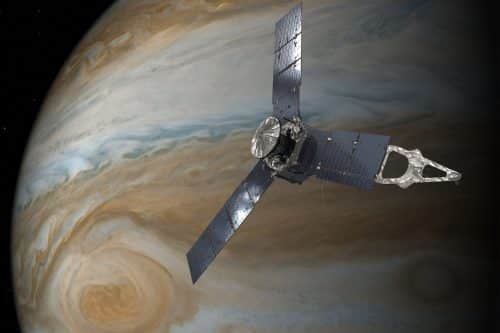For the past five years it has been circling Tzedek and transmitting to Israel a huge amount of photographs and information related to Tzedek. Since it has a large supply of fuel left, there are those who are thinking of extending its stay around Tedek. The intention is to study the large moons of the planet Io, Europa and Ganymede as well as the rings of Jupiter

The JUNO spacecraft orbiting Jupiter is about to finish its work in 2021. For the past five years it has been circling Tzedek and transmitting to Israel a huge amount of photographs and information related to Tzedek. Since it has a large supply of fuel left, there are those who are thinking of extending its stay around Tedek. The intention is to study the large moons of the planet Io, Europa Ganymede and the rings of Jupiter. For some reason they do not include Callisto, but who knows, maybe in the future they will decide to explore this moon as well. This program will be until 2025.
Juno orbits Jupiter in a polar orbit, which for the first time allowed it to photograph interesting phenomena at Jupiter's poles.
The intention is to operate the spacecraft like the Galileo spacecraft. JUNO will continue to orbit Jupiter and each time it will be directed towards one of these moons.
According to the proposed plan, the spacecraft will pass at a distance of 1000 km from Ganymede and make several passes near it. In 2021, Juno will pass within 320 km of Europa in 2022 and make two passes by Io in 2024.
A very impressive program. It will be possible to photograph areas not photographed by the Galileo spacecraft and repeat photographs of areas photographed by this spacecraft. In this case it will be possible to see if there have been any changes to the surface. It will be possible to learn from this about topographic changes of the surface and tectonic processes.
It is very possible that during the spacecraft's flight around Jupiter it will be possible to photograph some of the moons surrounding it, similar to those taken by the Cassini spacecraft that orbited Saturn.
As for the Europa moon, due to the short transit distance from it the resolution of the photographs will be 2-1 km per pixel. If the amount of fuel allows it, it will be possible to lower the transit distance of some of the transit flights near this moon. The intention is to map concentrations of water ice, sea carbon dioxide and organic organic molecules over 40% of its surface. Telescopic observations from Earth towards Europa have found evidence of water geysers erupting similar to what was seen on Saturn's moon Enceladus by the Cassini spacecraft. Maybe the JUNO spacecraft will be able to photograph geysers on Europa. It will also be possible to study the thickness of the water ice layer that covers large areas of the surface of the moon. It will be possible to measure where this layer is thin and where it is thick. All the findings from these transit flights will be used by the planners of the Europa Clipper spacecraft that will be launched to this moon in 2025. This program is a joint venture between NASA and the European Space Agency.
Regarding Ganymede, the intention is to map the composition of the soil and study the three-dimensional structure of its magnetosphere. Ganymede is the only moon in the solar system that has a magnetic field.

4 תגובות
Interrogating Ayo is a mistake, it's dangerous,
In the past it accelerated a research spacecraft that was out of use because of the radiation coming out of the star..
"A huge amount of photographs..." So why is there a picture of imaging??
Name
Justice also has rings. Read in the professional literature.
Haim! You mean Saturn's rings!